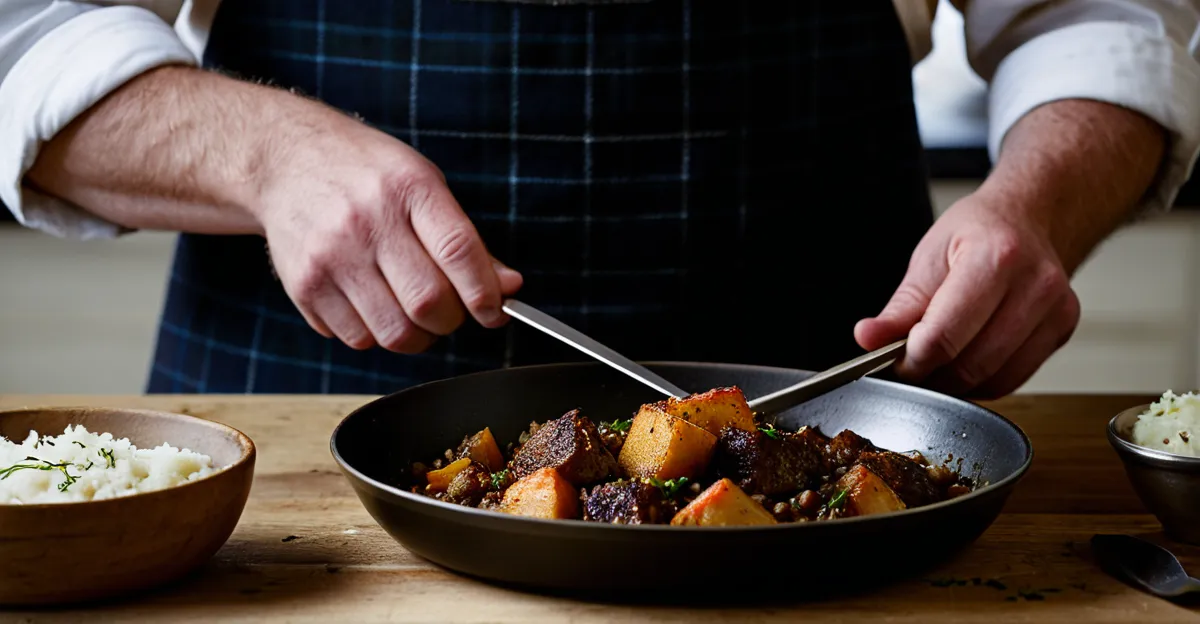Essential Ingredients for Traditional Scottish Haggis
Traditional haggis ingredients form the cornerstone of this iconic Scottish dish, combining a distinct blend of meats, grains, and seasonings with rich cultural significance. The primary haggis recipe components include sheep’s heart, liver, and lungs, which are collectively referred to as the pluck. These organs provide the essential flavors and textures that define authentic haggis. Proper sourcing of fresh and high-quality sheep’s offal is crucial to preserve the dish’s traditional essence.
Alongside the meats, Scottish haggis supplies commonly feature key grains like oats, which act both as a binder and a filler, imparting a hearty and slightly nutty taste. The inclusion of onions and suet adds depth and richness, while an array of spices such as black pepper, salt, and other seasonings bring balance and warmth to the mixture. These haggis recipe components work together to create the distinctive robustness associated with haggis.
Also to read : How Can Traditional UK Dishes Be Adapted for Modern Tastes?
A vital, yet often overlooked, ingredient is the casing—traditionally the sheep’s stomach—used to encase the filling. Sourcing natural casing is a key part of the traditional haggis experience. However, some modern adaptations may utilize artificial casings to accommodate availability or preferences while still aiming to respect the original recipe’s integrity. This careful selection of traditional haggis ingredients ensures both authenticity and quality in every bite.
Preparing and Cleaning the Haggis Ingredients
Preparing traditional haggis ingredients begins with thorough washing and boiling of the offal, specifically the sheep’s heart, liver, and lungs. This cleaning step is essential to remove impurities, blood, and any unwanted residues, ensuring the organs are safe and palatable for further use. Boiling also aids in softening the meats, making them easier to chop and mince in subsequent preparation stages.
Also read : How can you perfect the art of making a traditional black pudding?
After cleaning, the pluck is carefully chopped or minced along with suet to achieve the desired texture for the haggis filling mixture. The suet adds moisture and richness, balancing the lean nature of the meats. Pre-cooking oats is another important haggis preparation step, as it prevents rawness and helps the grains absorb flavors while binding the mixture. Onions are typically sautéed or finely diced to enhance taste and soften their bite before being combined.
Each phase of preparing and cleaning the haggis organs and grains reflects attention to detail, crucial for maintaining the integrity of traditional haggis recipe components. Proper prep ensures the haggis filling will have the right texture, flavor, and consistency for stuffing into the casing, preserving the authenticity that defines Scottish haggis supplies.
Mixing and Seasoning the Haggis Filling
Once the haggis preparation steps of cleaning and chopping the meats and pre-cooking the oats are complete, the next critical phase is creating a well-balanced haggis filling mixture. This process involves combining the minced sheep’s heart, liver, and lungs with the pre-cooked oats, finely chopped onions, and suet to achieve the correct texture and cohesion. The suet’s fat content adds moisture and richness, binding the mixture while preventing it from becoming dry or crumbly during cooking.
The haggis seasoning plays a pivotal role, traditionally consisting of salt, ground black pepper, and other warming spices like coriander or mace. These spices complement the robust flavor of the meats and the nuttiness of the oats, creating a distinctive and flavorful profile. Achieving the right balance is essential; too little seasoning results in blandness, while too much can overpower the subtle organ meats.
To ensure the filling mixture binds well and cooks evenly, it’s customary to test a small spoonful by frying it lightly. This test confirms the seasoning balance and the combining of haggis ingredients has created an ideal texture—neither too dry nor too wet. Adjustments can be made by adding more oats for firmness or additional suet for moisture. This thoughtful process guarantees that the haggis filling will hold together inside the casing and deliver the rich, hearty taste traditional to Scottish haggis supplies.
Stuffing and Securing the Haggis Casing
The final step before cooking involves stuffing haggis into its traditional casing, typically the cleaned sheep’s stomach. This is a delicate process that requires filling the casing evenly with the prepared haggis mixture, taking care not to overfill. Leaving adequate space inside the casing is crucial because it allows the haggis to expand during cooking without bursting, preserving the integrity of the dish.
Once filled, the next essential task is tying the haggis casing securely. Traditionally, butchers use strong kitchen twine to fasten both ends of the stomach, ensuring that no filling escapes during boiling. The tying technique involves making firm knots and sometimes creating a loop for easy handling in the pot. Properly closed casing is vital for even cooking and maintaining the haggis’s shape.
In situations where natural casing is unavailable or impractical, some cooks use artificial casings designed to withstand the boiling process, which still honor traditional Scottish methods. However, mastering the art of stuffing and securing the casing remains a key part of authentic haggis assembly instructions, as it directly impacts the texture and presentation of the final dish.
Cooking and Serving Traditional Scottish Haggis
Cooking haggis correctly is essential to achieve its characteristic texture and rich flavor. The traditional method involves submerging the stuffed haggis fully in a pot of gently simmering water. This slow boiling ensures even cooking and thorough heating throughout the sheep’s stomach casing, which protects the filling while allowing flavors to meld. Maintaining a steady simmer rather than a rolling boil prevents the casing from bursting, preserving the haggis’s shape and moisture.
The haggis boiling instructions typically advise cooking for about 1.5 to 2 hours, depending on size. During this period, the filling inside becomes tender as the oats absorb juices from the meats and spices, resulting in a hearty and cohesive mixture. It is important to ensure the haggis reaches a safe internal temperature—usually around 75°C (167°F)—to confirm the offal and grains are fully cooked and safe to serve.
When it comes to how to serve haggis, tradition often pairs it with simple yet complementary sides like neeps (mashed swede) and tatties (mashed potatoes), which balance the dish’s robust flavors. A drizzle of whisky sauce can add an extra depth of warmth, enhancing the haggis experience. Serving haggis hot, freshly boiled, and carefully sliced showcases its distinctive texture and honors the rich heritage of this celebrated Scottish dish.
Historical and Cultural Significance of Haggis
The Scottish haggis history dates back centuries, rooted in Scotland’s rural traditions where using every part of the animal was essential. Originally, haggis served as a practical dish for shepherds and farmers, utilizing sheep’s offal combined with oats and spices to create a nutritious, filling meal. Over time, this humble dish became deeply woven into Scottish culinary culture, symbolizing resourcefulness and local heritage.
Haggis holds a central place in haggis cultural traditions, especially during Burns Night, an annual celebration honoring Scotland’s national poet, Robert Burns. On this night, the haggis is ceremoniously presented with great respect and often accompanied by poetry recitations, marking its status not just as a food but as a cultural icon. This practice highlights haggis as a living element of Scottish identity, connecting modern Scots with their ancestors through shared customs.
Today, Burns Night haggis remains a vibrant tradition, but the dish also experiences modern adaptations that respect its origins while appealing to contemporary tastes. These variations maintain the soul of Scottish haggis supplies but often explore new presentations and ingredient tweaks. The interplay of tradition and innovation illustrates haggis’s enduring significance, making it much more than a meal—it is a celebration of Scotland’s history and cultural pride.



